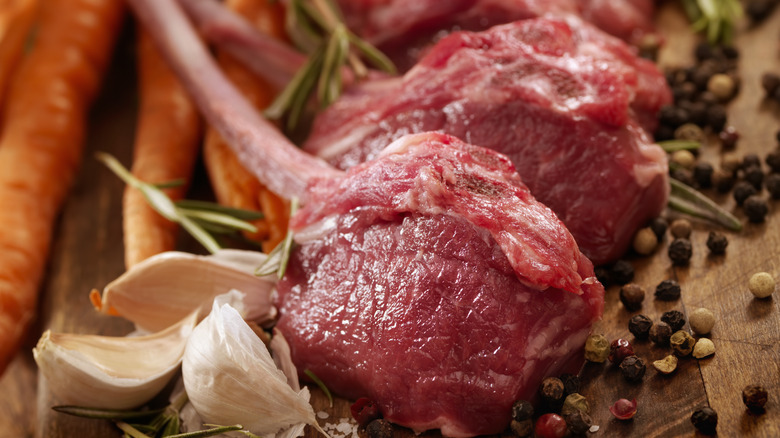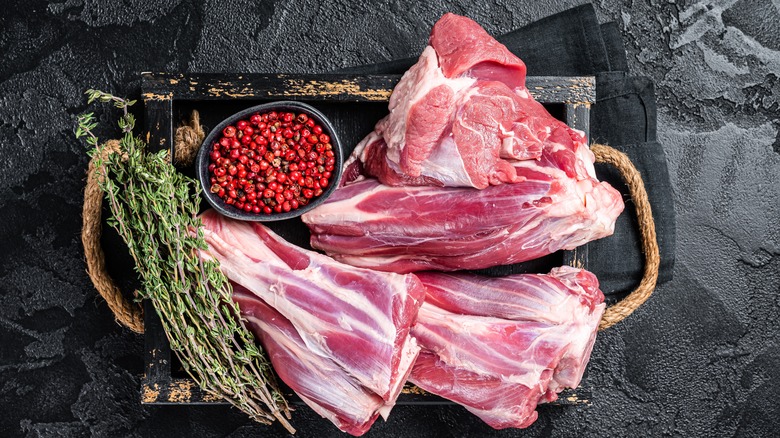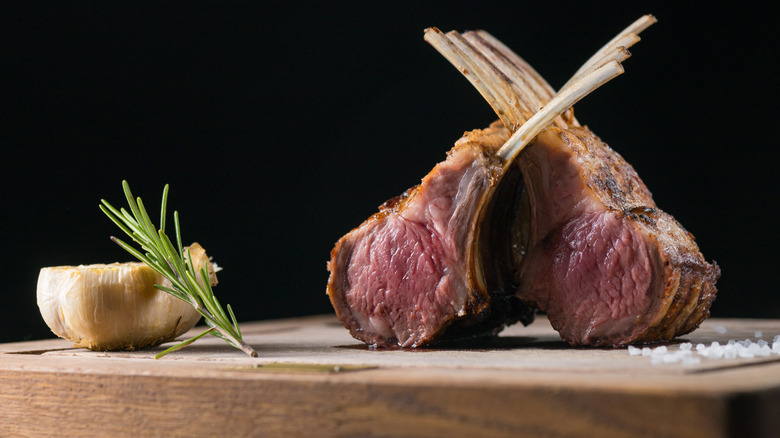The Common Mistake That Makes Lamb Mushy
Like most red meats, the best lamb dishes are ones that capitalize on the protein's tender texture and juicy center. But unlike ingredients such as pork and beef, lamb often isn't a weeknight go-to for home cooks in the U.S. Maybe it's because so many gifted chefs, like Gordon Ramsay and Ashley Palmer-Watts, serve delicate rack of lamb on their restaurant menus that we perceive the dish as too difficult to try at home. But, really, lamb can even be beginner-friendly if you avoid one crucial pitfall: over-marinating the meat, particularly with acidic ingredients.
Lamb is an incredibly delicate cut because it's also an incredibly young meat. However, because of its tender nature, it's easy to overestimate how much time it should spend in a marinade. The intended purpose, besides adding flavor, is to tenderize the cut — so letting already soft meat soak too long in the mixture will break down the proteins too much, leaving you with a mushy mess before your lamb even hits the pan.
After all, you want the meat to fall off the bone, but not fall apart. To cultivate this sweet spot, keep your marinating time to just 15-20 minutes. Any more and you may risk serving a paste rather than a succulent yet firm entree. Just remember — the shorter it marinates, the better.
How to properly prep and marinate lamb
A common concern when cooking lamb is whether the meat will taste gamey, which can distract from the rest of the dish's natural flavors. There are a couple of ways to get rid of that undesired taste, starting with a good soak. Many recipes recommend soaking lamb meat by cutting it with yogurt or milk, as the lactic acids will help break down any strange flavors.
But again, since something like yogurt is an acidic ingredient, you'll want to keep the time the lamb spends in the dairy bath between that 15-20 minute window. After soaking, rinse off the meat and trim as much fat as you can from the cut. Fat holds onto flavor, but it also holds onto that gamey taste. Once you've shaved down your lamb, prepare your next step — the seasonings.
A good lamb marinade consists of a balance of seasonings, acids, and oils. If you're going for a Mediterranean feel, consider adding mint, fennel, and coriander to complement the meat. Or, if you prefer an Indian-spiced leg of lamb, break out the chili powder, cumin, and ginger. Even if you feel like the meat could've spent a bit longer in the marinade, you can always reserve the mixture and spoon it over the protein while it browns in the pan. That way, you still get that extra dose of flavor without risking turning your mutton into mush.
Sear your lamb like a steak for the best results
Once your lamb is properly marinated and seasoned and it's ready for the stove, you'll want sear it like you would a small, tender beef filet. Just like with a juicy steak, this step will give your lamb a thick crust around the edges where the remaining fat and juices have rendered and caramelized. Meanwhile, on the inside, the meat should have a soft texture and pinkish-redish color, depending on your preferred temperature.
Most lamb recipes recommend serving the dish medium to medium rare with an internal temperature between 135 degrees Fahrenheit and 145 degrees Fahrenheit, with the latter being the recommended temperature according to the USDA. Because lamb typically calls for a thick sear on the outside, it can be difficult to gauge doneness on sight alone.
Even a few seconds too long on the stove can suck the juices out of such a delicate meat, so it's best to cut out the guesswork and leave the hard part to your thermometer. Don't forget to factor in resting time too — take the lamb out of the pan a few seconds early, as the internal temperature can still rise during the resting period. Once the meat has cooled, you can skip the steak knife. Trust us — if done correctly, you'll only need a fork and a napkin.



